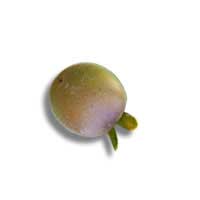 Full List of Fruits
Full List of Fruits  Texas Persimmon
Texas PersimmonTexas Persimmon
![]() Introduction of Texas Persimmon
Introduction of Texas Persimmon
Scientific name - Diospyros texana
Diospyros texana with several regional names like Texas persimmon, Mexican persimmon, chapote, chapote priet is a shrub that grows up to about 3 m high. Indigenous to central, south and west Texas, they are found at elevations from sea level to 1,800 m (5,900 ft). Having the male and female reproductive organs in separate individuals, it bears small black fruits that are cherry-sized. With a similar flavor of prunes, the fruits borne on female trees are fit for human consumption once soft and are relished by many birds and mammals. The fruits are black, subglobose berries which are of 1.5–2.5 cm (0.59–0.98 in). It contains three to eight small seeds that are triangular in shape and light red in color. Ideal for small spaces in full sun, they are extremely drought-tolerant and disease-resistant. In general, persimmons aren’t sweet enough to consume until they are very dark purple-black in color. The tree is valued high for its salient trunk and branches. They are well-shaped and are smooth pale grayish white or whitish grey.
![]() Nutritional Value of Texas Persimmon
Nutritional Value of Texas Persimmon
| Protein | 14 % |
| Phosphorus | 0.25% |
| Potassium | 1.55% |
| Calcium | 2.46% |
| Magnesium | 0.64% |
| Sodium | 0.08% |
Apart from the known use of the edible fruit the tree bears, its timber is highly luxurious and is strong, hard and rich deep red in color. The heart wood is sharply defined from the sapwood and takes a beautiful polish. Weighing 1008 kg per cubic meter, they are used in making furniture’s and also fine carvings are made out of it. The light fragranced flowers are used to make ornamental garlands.
![]() Health Benefits of Texas Persimmon
Health Benefits of Texas Persimmon
Almost all parts of the tree are considered useful, especially the bark, flowers, fruits together with its seeds are astringent, cooling, anthelmintic, tonic, and febrifuge. Mainly used in dental ailments like bleeding gums, pyorrhea, dental caries, and loose teeth, they are said to give great relief. Burning urination is cured with the ripened fruits. Decoction of bark is used as a wound cleaning lotion. Dried flowers powder is used as a brain tonic. Flower extracts are used to treat heart diseases, leucorrhoea, and menorrhagia, and act as antiduretic in polyuria and antitoxin.
As with the growth and development of the tree, the seedlings and tree grow slowly, but it may reach a height of 34 m in 20 years with a bole diameter of 50 cm, i.e. a mean annual diameter increment of 2.5 cm. All through the year, the trees may blossom and fruit.


















